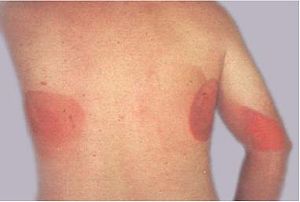
Acute radiodermatitis

A radiation burn is damage to the skin or other biological tissue as an effect of radiation. The radiation types of greatest concern are thermal radiation, radio frequency energy, ultraviolet light and ionizing radiation. A radiation burn is damage to the skin or other biological tissue as an effect of radiation. The radiation types of greatest concern are thermal radiation, radio frequency energy, ultraviolet light and ionizing radiation. The most common type of radiation burn is a sunburn caused by UV radiation. High exposure to X-rays during diagnostic medical imaging or radiotherapy can also result in radiation burns. As the ionizing radiation interacts with cells within the body—damaging them—the body responds to this damage, typically resulting in erythema—that is, redness around the damaged area. Radiation burns are often discussed in the same context as radiation-induced cancer due to the ability of ionizing radiation to interact with and damage DNA, occasionally inducing a cell to become cancerous. Cavity magnetrons can be improperly used to create surface and internal burning. Depending on the photon energy, gamma radiation can cause very deep gamma burns, with 60Co internal burns common. Beta burns tend to be shallow as beta particles are not able to penetrate deeply into the person; these burns can be similar to sunburn. Alpha particles can cause internal alpha burns if inhaled, with external damage (if any) being limited to minor erythema. Radiation burns can also occur with high power radio transmitters at any frequency where the body absorbs radio frequency energy and converts it to heat. The U.S. Federal Communications Commission (FCC) considers 50 watts to be the lowest power above which radio stations must evaluate emission safety. Frequencies considered especially dangerous occur where the human body can become resonant, at 35 MHz, 70 MHz, 80-100 MHz, 400 MHz, and 1 GHz. Exposure to microwaves of too high intensity can cause microwave burns. Radiation dermatitis (also known as radiodermatitis) is a skin disease associated with prolonged exposure to ionizing radiation.:131–2 Radiation dermatitis occurs to some degree in most patients receiving radiation therapy, with or without chemotherapy. There are three specific types of radiodermatitis: acute radiodermatitis, chronic radiodermatitis, and eosinophilic, polymorphic, and pruritic eruption associated with radiotherapy.:39–40 Radiation therapy can also cause radiation cancer.:40 With interventional fluoroscopy, because of the high skin doses that can be generated in the course of the intervention, some procedures have resulted in early (less than two months after exposure) and/or late (two months or more after exposure) skin reactions, including necrosis in some cases.:773 Radiation dermatitis, in the form of intense erythema and vesiculation of the skin, may be observed in radiation ports.:131 As many as 95% of patients treated with radiation therapy for cancer will experience a skin reaction. Some reactions are immediate, while others may be later (e.g., months after treatment). Acute radiodermatitis occurs when an 'erythema dose' of ionizing radiation is given to the skin, after which visible erythema appears up to 24 hours after.:39 Radiation dermatitis generally manifests within a few weeks after the start of radiotherapy.:143 Acute radiodermatitis, while presenting as red patches, may sometimes also present with desquamation or blistering. Erythema may occur at a dose of 2 Gy radiation or greater.
